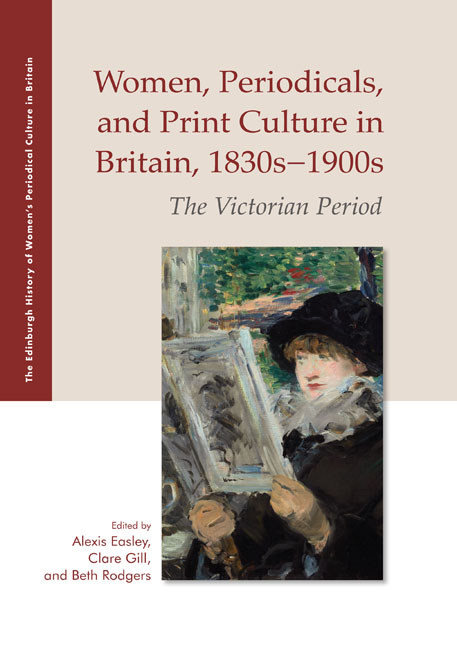Book contents
- Frontmatter
- Contents
- List of Illustrations
- Acknowledgments
- Introduction: Women, Periodicals, and Print Culture in the Victorian Period
- Part I (Re)Imagining Domestic Life
- Part II Constructing Modern Girls and Young Women
- Constructing Modern Girls and Young Women: Introduction
- 7 Promoting a Do-It-Yourself Spirit: Samuel Beeton's Young Englishwoman
- 8 Claiming Medicine as a Profession for Women: The English Woman's Journal's Campaign for Female Doctors
- 9 Encouraging Charitable Work and Membership in the Girls’ Friendly Society through British Girls’ Periodicals
- 10 ‘Welcome and Appeal for the “Maid of Dundee”’: Constructing the Female Working-Class Bard in Ellen Johnston's Correspondence Poetry, 1862–1867
- 11 The Editor of the Period: Alice Corkran, the Girl's Realm, and the Woman Editor
- 12 The ‘Most-Talked-Of Creature in the World’: The ‘American Girl’ in Victorian Print Culture
- Part III Women and Visual Culture
- Part IV Making Space for Women
- Part V Constructing Women Readers and Writers
- Part VI Intervening in Political Debates
- Notes on Contributors
- Index
- Plate section
12 - The ‘Most-Talked-Of Creature in the World’: The ‘American Girl’ in Victorian Print Culture
from Part II - Constructing Modern Girls and Young Women
Published online by Cambridge University Press: 25 October 2019
- Frontmatter
- Contents
- List of Illustrations
- Acknowledgments
- Introduction: Women, Periodicals, and Print Culture in the Victorian Period
- Part I (Re)Imagining Domestic Life
- Part II Constructing Modern Girls and Young Women
- Constructing Modern Girls and Young Women: Introduction
- 7 Promoting a Do-It-Yourself Spirit: Samuel Beeton's Young Englishwoman
- 8 Claiming Medicine as a Profession for Women: The English Woman's Journal's Campaign for Female Doctors
- 9 Encouraging Charitable Work and Membership in the Girls’ Friendly Society through British Girls’ Periodicals
- 10 ‘Welcome and Appeal for the “Maid of Dundee”’: Constructing the Female Working-Class Bard in Ellen Johnston's Correspondence Poetry, 1862–1867
- 11 The Editor of the Period: Alice Corkran, the Girl's Realm, and the Woman Editor
- 12 The ‘Most-Talked-Of Creature in the World’: The ‘American Girl’ in Victorian Print Culture
- Part III Women and Visual Culture
- Part IV Making Space for Women
- Part V Constructing Women Readers and Writers
- Part VI Intervening in Political Debates
- Notes on Contributors
- Index
- Plate section
Summary
IN JUNE 1890, THE North American Review published an article about the experiences of ‘American Girls in Europe.’ Its author, the American writer and socialite M. E. W. Sherwood, celebrated the ‘triumphant march’ of a new generation of ‘lovely Amazons’ who were marrying the best of the British elite (689). Never before, she argued,
did the women of one nation so successfully invade all nations and, reversing the Sabine legend, carry off the most able-bodied warriors. The march over England and the Continent by the American girl is … a great story of conquest…. No women are more courted, admired and praised. (689)
Among these admirers was the British journalist and editor W. T. Stead. A month later, in the Review of Reviews, he urged English girls to seek out Sherwood's article, and others like it, ‘in order to understand how hopelessly they [were] being beaten out of the field by their cousins from across the sea’ (July 1890: 40). They would not have needed to look far. During the 1880s and 1890s, the American girl was, as Sherwood put it, one of the ‘most-talked-of creatures in the world’ (North American Review June 1890: 689). As this chapter will demonstrate, she appeared across thousands of newspapers, periodicals, critical reviews, women's magazines, novels, satirical cartoons, and other forms of late Victorian print culture. Her accomplishments, ambitions, and actions were exhaustively discussed and fiercely contested by commentators on both sides of the Atlantic. To some, she was an object of lustful fascination, an intoxicating combination of beauty, intelligence, wealth, and modernity. ‘It is,’ explained a love-struck contributor to the London Journal, ‘her freshness, her independence, her modern ideas, her indifference to threadbare conventionalities and old-time fashions that charm us’ (26 Sep 1896: 279). Her detractors, on the other hand, typically interpreted these qualities as faults. As an anonymous literary celebrity explained to Sherwood during one of her visits to London, ‘We observe in your handsome young women an entire absence of that delicate reserve, that fragrance of propriety, which is our idea of good breeding’ (North American Review June 1890: 684). To these critics, the American girl was ‘vulgar,’ ‘strange,’ ‘fast,’ and – horror of all horrors – prone to ‘speaking through her nose’ and using coarse Yankee slang.
- Type
- Chapter
- Information
- Women, Periodicals and Print Culture in Britain, 1830s–1900sThe Victorian Period, pp. 178 - 196Publisher: Edinburgh University PressPrint publication year: 2019

